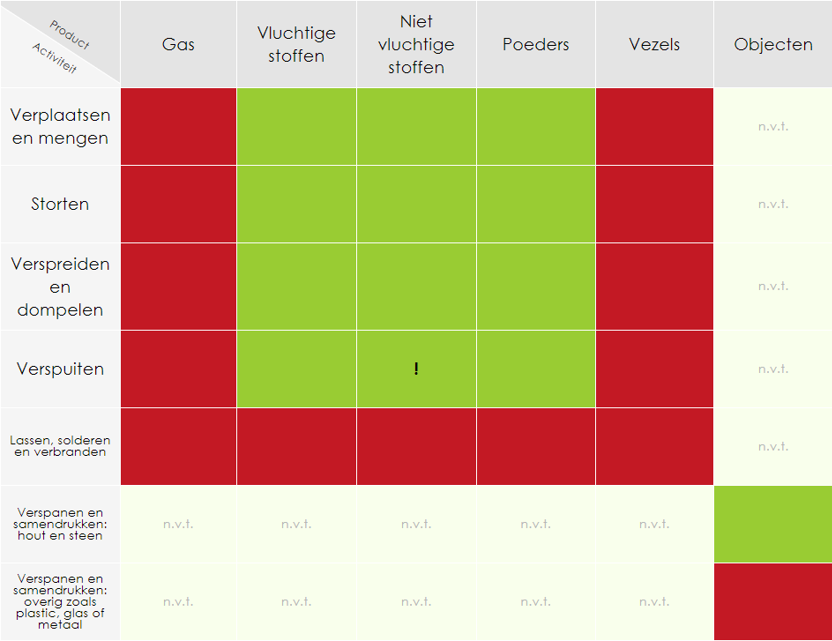
Wat is Stoffenmanager®?
Achtergrond
Stoffenmanager® is gevalideerd op basis van meer dan 7000 metingen en wordt (inter)nationaal erkend door lokale overheden en de EU. Met Stoffenmanager® doorloopt u de vier stappen van de Zelfinspectietool Gevaarllijke Stoffen van SZW. Stoffenmanager® wordt genoemd in de REACH R.14 Guidance van the European Chemicals Agency (ECHA, August 2016): "Table R14-13: Domain of reliable application of Stoffenmanager® (the algorithms can only be found at www.stoffenmanager.com in its most recent version)".
Alhoewel Stoffenmanager® wereldwijd kan worden toegepast, kunnen de ontwikkelaars alleen garanderen dat wijzigingen in de EU en/of Nederlandse wetgeving zullen worden meegenomen in de ontwikkeling van de tool. Buiten de EU is het de verantwoordelijkheid van de gebruiker om te controleren of lokale wetgeving het gebruik van Stoffenmanager® accepteert.
Validatie
Stoffenmanager® ontwikkelt continu door. Niet alleen functionaliteiten worden verbeterd of uitgebreid, maar ook de onderliggende rekenregels.
Prioriteren
Stoffenmanager® versie 7.0 en later classificeert de gevaren van een product op basis van de H-zinnen zoals beschreven in Arnone et al (2015). De classificatie in eerdere versies was gebaseerd op COSHH Essentials. Het blootstellingsmodel voor inademing van Stoffenmanager® is gebaseerd op de bron-receptor benadering van Cherrie en Schneider (1999) en Marquart et al (2008) (versie 3.5)). Latere wijzigingen in het model zijn onder een geheimhoudingsovereenkomst beschikbaar voor autoriteiten en wetenschappelijke partners.
Het model voor het schatten van huidblootstelling is gebaseerd op de RISKOFDERM Toolkit (Goede et al (2003).
Beoordelen
De kwantificering van het blootstellingsmodel voor inademing van Stoffenmanager® versie 3.0 en 3.5 wordt beschreven in Tielemans et al (2008). Een verdere verfijning van het model (Stoffenmanager® versie 4.0) gebaseerd op ongeveer 1000 metingen is gepubliceerd in Schinkel et al (2010). De auteurs concluderen dat de 90-percentiel schatting voldoende conservatief is. Latere Stoffenmanager® versies zijn vervolgens in diverse studies verder gevalideerd en /of vergeleken met andere tools. Inmiddels is de validatie van de tool gebaseerd op meer dan 7000 metingen. Uit deze studies kan geconcludeerd worden dat Stoffenmanager® de meest gebalanceerde, robuuste en voldoende conservatieve tool is. Met uitzondering dat de blootstelling aan laag-vluchtige stoffen, vrijkomend als gevolg van spuitwerkzaamheden die buiten plaatsvinden zonder lokale afzuiging (aerosolformatie - PROC11), mogelijk wordt onderschat Tongeren van et al (2017).
Toepassingsgebied
- Groen: blootstelling aan inhaleerbaar stof (poeders, verspanend hout/steen) en respirabel stof (enkel verspanend steen) kan in Stoffenmanager® worden beoordeeld
- Rood: valt buiten het toepassingsdomein van Stoffenmanager®
- N.v.t.: Niet van toepassing, deze situatie kan niet voorkomen
- !: Blootstelling aan laag-vluchtige stoffen, vrijkomend als gevolg van spuitwerkzaamheden die buiten plaatsvinden zonder lokale afzuiging (aerosolformatie - PROC7 en PROC11; ‘Werken met vloeistoffen bij hoge druk waarbij zichtbaar een mist of nevel ontstaat’), wordt mogelijk onderschat (gebaseerd op Tongeren van et al (2017)). Voor deze activiteit wordt aangeraden om uit te gaan van de 95-percentiel schatting of te toetsen aan een RCR = 0.5 (i.p.v. RCR= 1).
Verder wordt verwezen naar de REACH R.14 Guidance (A.14-1.4.1.1. Applicability domain). Hier wordt weergegeven voor welke PROCs Stoffenmanager® NIET gebruikt kan worden. Wijzigingen in de modellen zijn onder een geheimhoudingsovereenkomst beschikbaar voor autoriteiten en wetenschappelijke partners.
Referenties
Arnone, M., Koppisch, D., Smola, T., Gabriel, S., Verbist, K., & Visser, R. (2015). Hazard banding in compliance with the new Globally Harmonised System (GHS) for use in control banding tools. Regulatory Toxicology and Pharmacology, 73(1), 287–295. https://doi.org/10.1016/j.yrtph.2015.07.014
Cherrie, J.W., Schneider, T. (1999). Validation of a New Method for Structured Subjective Assessment of Past Concentrations. The Annals of Occupational Hygiene, 43(4), 235-245.
https://doi.org/10.1093/annhyg/43.4.235
Cherrie, J. W., Fransman, W., Heussen, G. A. H., Koppisch, D., & Jensen, K. A. (2020). Exposure Models for REACH and Occupational Safety and Health Regulations. International Journal of Environmental Research and Public Health, 17(2), 383.
https://doi.org/10.3390/ijerph17020383
Van Duuren-Stuurman, B., Vink, S. R., Verbist, K. J. M., Heussen, H. G. A., Brouwer, D. H., Kroese, D. E. D., Van Niftrik, M. F. J., Tielemans, E., Fransman, W. (2012). Stoffenmanager Nano Version 1.0: A Web-Based Tool for Risk Prioritization of Airborne Manufactured Nano Objects, The Annals of Occupational Hygiene, 56(5), 525–541.
https://doi.org/10.1093/annhyg/mer113
Fransman, W., Arnone, M., Borghi, F., Cattaneo, A., Cavallo, D. M., Cherrie, J. W., Franken, R., Galea, K. S., van der Haar, R., Heussen, G. A. H., Jensen, K. A., Koponen, M., Koppisch, D., Kromhout, H., Luo, Y. S., McNally, K., Säämänen, A., Spinazzè, A., van Tongeren, M., Vanoirbeek, J., Verpaele, S., Vetter, D., Viegas, S., Warren, N. (2022). Response Letter to Koivistoet et al. ‘Evaluating the Theoretical Background of STOFFENMANAGER® and the Advanced REACH Tool’. Annals of Work Exposures and Health, 66(4), 543–549.
https://doi.org/10.1093/annweh/wxac001
Goede, H. A., Tijssen, S. C. H. A., Schipper, H. J., Warren, N., Oppl, R., Kalberlah, F., Van Hemmen, J. J. (2003). Classification of Dermal Exposure Modifiers and Assignment of Values for a Risk Assessment Toolkit, The Annals of Occupational Hygiene, 47(8), 609–618. https://doi.org/10.1093/annhyg/meg070
Heussen, H., Hollander, A., Verbist, K. (2020). Stoffenmanager® preventie platfor- Op weg naar een persoonlijk blootstellingsdossier gevaarlijke stoffen, Tijdschrift voor Toegepaste Arbowetenschap, 33(3), 104-112.
TtA 2020-03 def.pdf (arbeidshygiene.nl)
Huang, S., & Wu, K. (2019). Health Risk Assessment of Photoresists Used in an Optoelectronic Semiconductor Factory. Risk Analysis, 39(12), 2625–2639.
https://doi.org/10.1111/risa.13366
Huang, S. Z., Chuang, Y. C., Hung, P. C., Chen, C. Y., Chiang, S. Y., & Wu, K. Y. (2020). Incorporating Exposure Measurement Data from Similar Exposure Scenarios to Inform Exposure Modeling Estimates: A Demonstration Using Cluster Analysis and Bayesian Modeling. Annals of Work Exposures and Health, 65(1), 96–112.
https://doi.org/10.1093/annweh/wxaa088
Jankowska, A., Czerczak, S., Kucharska, M., Wesołowski, W., Maciaszek, P., & Kupczewska-Dobecka, M. (2015). Application of predictive models for estimation of health care workers exposure to sevoflurane. International Journal of Occupational Safety and Ergonomics, 21(4), 471–479. https://doi.org/10.1080/10803548.2015.1086183
Koppisch, D., Schinkel, J., Gabriel, S., Fransman, W., Tielemans, E. (2012). Use of the MEGA Exposure Database for the Validation of the Stoffenmanager Model, The Annals of Occupational Hygiene, 56(4), 426–439.
https://doi.org/10.1093/annhyg/mer097
Lamb, J., Galea, K. S., Miller, B. G., Hesse, S., & Van Tongeren, M. (2017). Between-User Reliability of Tier 1 Exposure Assessment Tools Used Under REACH. Annals of Work Exposures and Health, 61(8), 939–953.
https://doi.org/10.1093/annweh/wxx074
Landberg, H. E., Berg, P., Andersson, L., Bergendorf, U., Karlsson, J. E., Westberg, H., & Tinnerberg, H. (2015b). Comparison and Evaluation of Multiple Users’ Usage of the Exposure and Risk Tool: Stoffenmanager 5.1. Annals of Occupational Hygiene, 59(7), 821–835. https://doi.org/10.1093/annhyg/mev027
Landberg, H. E., Axmon, A., Westberg, H., & Tinnerberg, H. (2017). A Study of the Validity of Two Exposure Assessment Tools: Stoffenmanager and the Advanced REACH Tool. Annals of Work Exposures and Health, 61(5), 575–588.
https://doi.org/10.1093/annweh/wxx008
Landberg, H. (2018). The Use of Exposure Models in Assessing Occupational Exposure to Chemicals. [Doctoral Thesis (compilation), Department of Laboratory Medicine]. Lund University: Faculty of Medicine.
https://lucris.lub.lu.se/ws/portalfiles/portal/37105703/Kappa2017_12_21_a.pdf
Landberg, H. E., Westberg, H., & Tinnerberg, H. (2018). Evaluation of risk assessment approaches of occupational chemical exposures based on models in comparison with measurements. Safety Science, 109, 412–420.
https://doi.org/10.1016/j.ssci.2018.06.006
Lee, E. G., Lamb, J., Savic, N., Basinas, I., Gasic, B., Jung, C., Kashon, M. L., Kim, J., Tischer, M., van Tongeren, M., Vernez, D., & Harper, M. (2018). Evaluation of Exposure Assessment Tools under REACH: Part II—Higher Tier Tools. Annals of Work Exposures and Health, 63(2), 230–241. https://doi.org/10.1093/annweh/wxy098
Lee, S., Lee, K., & Kim, H. (2018). Comparison of Quantitative Exposure Models for Occupational Exposure to Organic Solvents in Korea. Annals of Work Exposures and Health, 63(2), 197–217.
https://doi.org/10.1093/annweh/wxy087
Lee, E. G. (2023). Evaluation of Stoffenmanager® and ART for Estimating Occupational Inhalation Exposures to Volatile Liquids. Annals of Work Exposures and Health.
https://doi.org/10.1093/annweh/wxac091
Marquart, H., Heussen, H., Le Feber, M., Noy, D., Tielemans, E., Schinkel, J., West, J., Van Der Schaaf, D. (2008). ‘Stoffenmanager’, a Web-Based Control Banding Tool Using an Exposure Process Model, The Annals of Occupational Hygiene, 52(6), 429-441. https://doi.org/10.1093/annhyg/men032
Ribalta, C., López-Lilao, A., Estupiñá, S., Fonseca, A., Tobías, A., García-Cobos, A., Minguillón, M., Monfort, E., & Viana, M. (2019). Health risk assessment from exposure to particles during packing in working environments. Science of The Total Environment, 671, 474–487. https://doi.org/10.1016/j.scitotenv.2019.03.347
Ribalta, C., Koivisto, A. J., López-Lilao, A., Estupiñá, S., Minguillón, M. C., Monfort, E., & Viana, M. (2019). Testing the performance of one and two box models as tools for risk assessment of particle exposure during packing of inorganic fertilizer. Science of The Total Environment, 650, 2423–2436.
https://doi.org/10.1016/j.scitotenv.2018.09.379
Riedmann, R. A., Gasic, B., & Vernez, D. (2015). Sensitivity Analysis, Dominant Factors, and Robustness of the ECETOC TRA v3, Stoffenmanager 4.5, and ART 1.5 Occupational Exposure Models. Risk Analysis, 35(2), 211–225.
https://doi.org/10.1111/risa.12286
Schinkel, J., Fransman, W., Heussen, H., Kromhout, H., Marquart, H., & Tielemans, E. (2009). Cross-validation and refinement of the Stoffenmanager as a first tier exposure assessment tool for REACH. Occupational and Environmental Medicine, 67(2), 125–132. https://doi.org/10.1136/oem.2008.045500
Schlüter, U., Arnold, S., Borghi, F., Cherrie, J., Fransman, W., Heussen, H., Jayjock, M., Jensen, K. A., Koivisto, J., Koppisch, D., Meyer, J., Spinazzè, A., Tanarro, C., Verpaele, S., & von Goetz, N. (2022). Theoretical Background of Occupational-Exposure Models—Report of an Expert Workshop of the ISES Europe Working Group “Exposure Models”. International Journal of Environmental Research and Public Health, 19(3), 1234.
https://doi.org/10.3390/ijerph19031234
Spinazzè, A., Lunghini, F., Campagnolo, D., Rovelli, S., Locatelli, M., Cattaneo, A., & Cavallo, D. M. (2017). Accuracy Evaluation of Three Modelling Tools for Occupational Exposure Assessment. Annals of Work Exposures and Health, 61(3), 284–298.
https://doi.org/10.1093/annweh/wxx004
Spinazzè, Borghi, Campagnolo, Rovelli, Keller, Fanti, Cattaneo, & Cavallo. (2019). How to Obtain a Reliable Estimate of Occupational Exposure? Review and Discussion of Models’ Reliability. International Journal of Environmental Research and Public Health, 16(15), 2764. https://doi.org/10.3390/ijerph16152764
Schlüter, U., Meyer, J., Ahrens, A., Borghi, F., Clerc, F., Delmaar, C., Di Guardo, A., Dudzina, T., Fantke, P., Fransman, W., Hahn, S., Heussen, H., Jung, C., Koivisto, J., Koppisch, D., Paini, A., Savic, N., Spinazzè, A., Zare Jeddi, M., & von Goetz, N. (2022). Exposure modelling in Europe: how to pave the road for the future as part of the European Exposure Science Strategy 2020–2030. Journal of Exposure Science & Environmental Epidemiology, 32(4), 499–512.
https://doi.org/10.1038/s41370-022-00455-4
Tielemans, E., Noy, D., Schinkel, J., Heussen, H., Van Der Schaaf, D., West, J., Fransman, W. (2008). Stoffenmanager Exposure Model: Development of a Quantitative Algorithm, The Annals of Occupational Hygiene, 52(6), 443–454.
https://doi.org/10.1093/annhyg/men033
Tielemans, E., Schneider, T., Goede, H., Tischer, M., Warren, N., Kromhout, H., Van Tongeren, M., Van Hemmen, J., Cherrie, J. W. (2008). Conceptual Model for Assessment of Inhalation Exposure: Defining Modifying Factors, The Annals of Occupational Hygiene, 52(7),577–586. https://doi.org/10.1093/annhyg/men059
van Tongeren, M., Lamb, J., Cherrie, J. W., MacCalman, L., Basinas, I., & Hesse, S. (2017). Validation of Lower Tier Exposure Tools Used for REACH: Comparison of Tools Estimates With Available Exposure Measurements. Annals of Work Exposures and Health, 61(8), 921–938. https://doi.org/10.1093/annweh/wxx056
Stoffenmanager® for smart chemicals management and business continuity - OSHWiki. (z.d.).
Verbist, K., Marquart, H., Heussen, H., Schinkel, J., West, J., Fransman, W., van Niftrik, M., Tielemans, E. (2011). Stoffenmanager: een web-based control banding tool, Tijdschrift voor toegepaste Arbowetenschap, 3, 92-104.
https://www.arbeidshygiene.nl/-uploads/files/insite/2011-03-full-paper-verbist.pdf
Vink, S., Mikkers, J., Bouwman, T., Marquart, H., & Kroese, E. (2010). Use of read-across and tiered exposure assessment in risk assessment under REACH – A case study on a phase-in substance. Regulatory Toxicology and Pharmacology, 58(1), 64–71. https://doi.org/10.1016/j.yrtph.2010.04.004
Zalk, D. M., & Nelson, D. I. (2008). History and Evolution of Control Banding: A Review. Journal of Occupational and Environmental Hygiene, 5(5), 330–346.
https://doi.org/10.1080/15459620801997916
Zalk, D. M., & Heussen, G. H. (2011). Banding the World Together; The Global Growth of Control Banding and Qualitative Occupational Risk Management. Safety and Health at Work, 2(4), 375–379.
https://doi.org/10.5491/shaw.2011.2.4.375
